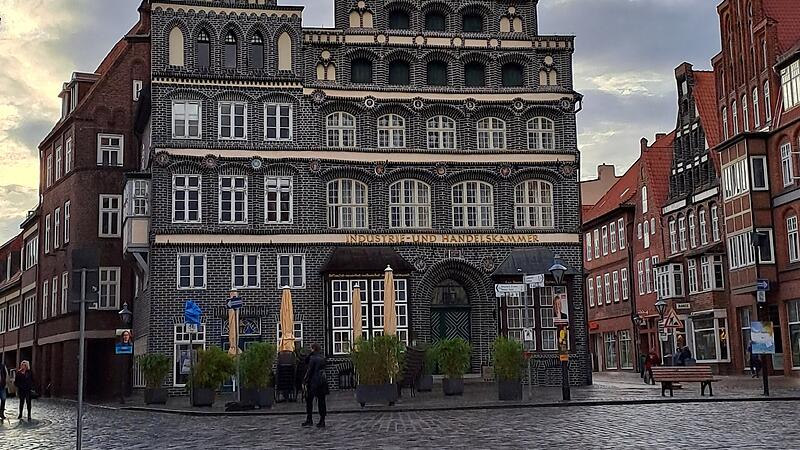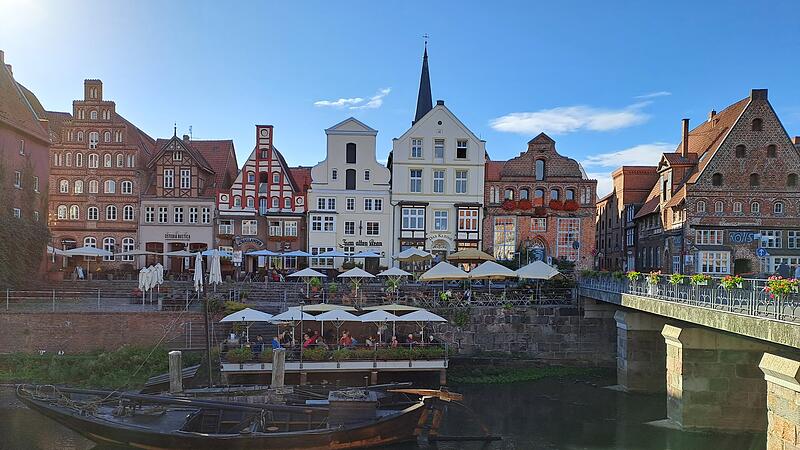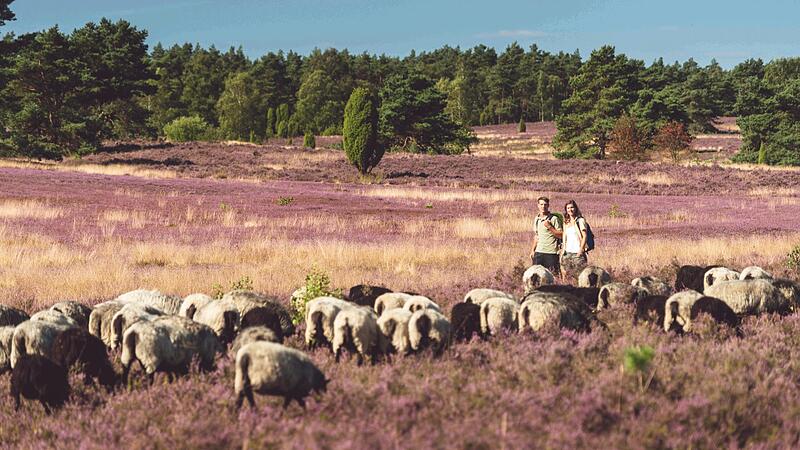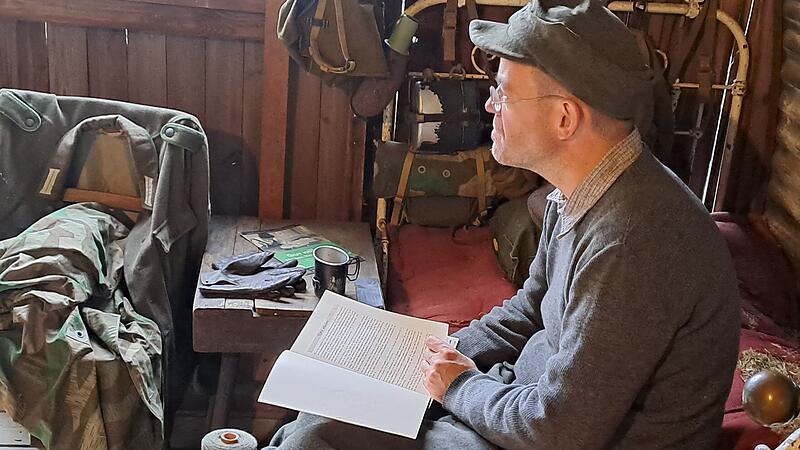Not Paris, not Venice, no, Lüneburg sings about the band “Top for Tea” as the “most beautiful city in the world”. The residents agree and are not surprised at the stable number of visitors throughout the year. As a backdrop for the telenovela “Red Roses” you need picturesque facades, lively squares and romantic alleys. The magic endures, even when it’s autumn on the edge of the Lüneburg Heath. Travelers should learn from the calmness of the people of Lüneburg and not let the rain showers take away their joy of discovery. “Moin” is the greeting in the salt and Hanseatic city at any time of the day. First of all we fortify ourselves for the city safari at the food truck of the Hotel Wyndberg under strong market umbrellas, which brave the pouring rain just as much as the storm-proof waiter. It tears open just in time for the espresso.


City guide Carolin Schäfer is beaming like the sun and enthusiastically tells anecdotes about magnificent gables, baroque facades and ornaments, such as the expensive brick rosettes on the house of the “very rich” Sülfmeister (owner of several salt pans) Hinrik Garlop in Der Reitende-Diener -Street. Construction hoppalas resulted in bizarre shapes. In 1384, for example, the master builder erected the tower of St. John’s anything but perpendicular and allegedly threw himself off it out of shame. He survived, only to break his neck drunk with joy and the pagan spirit that same day.
1400 houses are listed and breathe history. Just like the “pregnant house”, which has its raised belly from the bungling with plaster mortar and has nevertheless survived the centuries. The western old town is completely at an angle because the salt dome is below it. Salt boiling was mentioned in documents as early as 950. The mining of the “white gold”, which helped the city to immense wealth in the Middle Ages and the Renaissance, became a curse when the earth under the houses gave way by up to three meters and the district sagged several times. Today the danger has been averted, earth movement is minimal and the residential area is popular for its crooked charm.


The best all-round view of the city and the Lower Saxony plains can be experienced from the water tower, a museum and information center on the subject of H2O. The old harbor at the Stintmarkt presents itself beautifully, where the Ilmenau river – now lined with cafés and restaurants – was once the traffic route for transporting the salt to the north. Incidentally, the “smelt” is a small, herring-like fish that was caught and traded here. A regional specialty that is in season in February and March. Now you have to choose a place from the more than 300 restaurants, cafés, bars and pubs. Lüneburg scores with the largest density of pubs in Germany. The poet Heinrich Heine, who was quite bored with his relatives at Ochsenmarkt 1, would certainly have fun in the fairytale town today. We still find space in the quaint and lively Mälzer brewery and table house with copper brew kettles and a fine selection of beers.
However, Heine was drawn to the gentle landscape of the surrounding area, he often longed “for the smell of peat, for the lovely Heidschnucke sheep of the Lüneburg Heath…” Which brings us to the stars of the region and the gardeners of the romantic cultural landscape: the sheep with their black faces and powerful horns. Because if you leave other nature reserves untouched, the heath landscape only survives if the thirteen herds of Heidschnucke sheep keep it free of tree saplings and grasses. All year round the animals roam the landscape with their shepherds and also keep the common heather and bell heather, Erica calluna and Erica tetralix, short. We are in the Radenbachtal on a stage of the Heidschnuckenweg, a 223 km long long-distance hiking trail that leads from Hamburg-Neugraben-Fischbek to Celle.
With respect through the heath
We are not allowed to run into the heath in high spirits and look for Heidschnucke, because as one of the largest and oldest nature reserves in Germany, the heath is subject to strict rules – absolute freedom from cars is one of them. Hiking and riding trails are separated, you can walk undisturbed on knee-friendly sandy paths. Cyclists are also looking for deceleration instead of speed and behave accordingly considerately.
Heath ranger Jan Brockmann enlightens us about the origin, soil conditions, climatic and environmental influences and the life of the “Heidjer”, the people who lived in and from the heath. Sounds dry, but it’s not, because Jan refutes the cliché of the taciturn Lower Saxony and captivates with interesting connections. Only rye, oats and buckwheat could be wrested from the extremely barren soil by mixing the Schnucken dung with living humus from the heather and spreading it on the field.
Heath sheep on the plate
Life was hard, but modest prosperity was possible with wool and bee products until the imported goods of cotton and sugar triggered a wave of emigration. We could listen forever and not even notice that we have climbed the Wilseder Berg, the highest peak in the North German Plain and that we are 169 meters above sea level. The “summit” is celebrated with a certificate and a stamperl Heidegeist. At lunchtime in the Melkhus in the museum village of Wilsede, the Heidschnucke are represented again – in the form of minced patties and sausages.


With all the thirst for knowledge, you want to let the silence work on you at the latest at the “Totengrund”. The wide heathland is peppered with juniper bushes, the “guardians”. At night, the souls of the deceased wake up here to say goodbye. That’s what the saying goes and you believe it when the clouds lower and create mystical light-shadow effects. The hard-working Heidschnucke didn’t show up today, and yet it’s as if they accompanied us through the still blooming heath. At the Stimbekhof, the young restaurateur team welcomes us by the crackling open fire with homemade waffles and we start chatting. For example, why the horse heads that adorn the typical gables of thatched roofs sometimes point outwards, sometimes inwards: Each hamlet has its own interpretation of this, e.g. E.g. horses that look at each other bring good luck, those that turn away protect from misfortune. But we also learn a lot about hospitality, sustainability and cooperation with regional trades. Local specialties – a good gin made from juniper trees from the heath is a must – can be bought right at the farm.
A new day, a new landscape. And North German “Schietwetter”. During the night it rained heavily on the thatched roof and it doesn’t stop. However, after an extremely dry summer, it is sorely needed for the high moors, which are also protected.
North paths through the moor
“Dör’t Moor”, i.e. through the moor, should be the route today in the district of Rotenburg an der Wümme. We walk on paths that have only existed since 2014. “Dör’t Moor” has already made it to number one in 2021 as “Germany’s most beautiful hiking trail”. “And without mountains and valleys,” explains guide Udo Fischer, initiator and driving force behind the implementation of the project. “We have 24 northern trails in the district, all of which we have created from scratch. There was already cycling tourism, and many people didn’t believe that you could enjoy hiking through the moor. But the audience award in ‘Wandermagazin’ makes us very proud of what we have achieved. “
We start at Bullensee and walk on mulched paths, over wooden bridges that are not on the water but on the ground due to the months of drought. The path leads us through the forest, which repeatedly reveals views of mystical moorland. Plants such as gale, cranberry and sundew grow here. The moor is a paradise for birds. The greatest spectacle is provided by the cranes, which rest on the moor meadows on their way to and from the south.
Since there are no rest stops along the route, the Nordpfade team came up with the “Tischlein-deck-dich” for groups. Fine finger food picnics in the countryside can be booked. Two Rotenburg restaurants serve in an original sheep pen that has been freed from dung as a precaution.


Finally, we travel back through time and land directly in the year 1904. In the “Kiekeberg” open-air museum in the district of Harburg, volunteers slip into traditional costumes and historical costumes on “Days of Living History” and demonstrate everyday life in the past. A farmer’s wife shoos her geese in front of her, a fisherman is tying his net in front of the cottage, the sewing machine is whirring in the living room and busy hands are spinning wool. The museum is particularly popular with families, as history can be experienced here in the truest sense of the word.
One is proud of the emerging “Königsberger Straße”, which shows everyday pictures from 1945 to 1970. The latest achievement is the original gas station from 1956, when fuel cost 35 pfennigs.
History lesson with goosebumps
A shudder gripped us in a “Nissenhaus”, a tin barracks in which people whose homes had been bombed, refugees and those returning from the war found accommodation at the end of the Second World War. Hardship and tightness are immediately noticeable. At the table, people share a snack, the mother spreads “false liver sausage” – an oatmeal and onion spread with marjoram – on coarse bread. A war invalid is still wearing the bloody head bandage, an old man in a worn policeman’s coat is peeling potatoes, he carefully picks up the peels. The scenery is so authentic that an elderly lady, reminded of her childhood, furtively wipes away her tears.
accomodation
C. Wyndberg Lüneburg: Egersdorffstrasse 1a, 21335 Lüneburg
Hotel, restaurant, distillery. Reception under exposed ceiling beams with restored painting. The house was built in its original form in 1438, today it is a combination of historical details and modern furnishings.
Stimbekhof: Oberhaverbeck 2, 29646 Bispingen
Coach house, coach house, Schnuckenstall, granary, main house and stables, lovingly furnished oasis of well-being on the edge of the heath.
To the monastery mill: Kuhmühler Weg 7, 127419 Groß Meckelsen/Sittensen, individual rooms, conference hotel, quiet location in the countryside.
Left
lueneburger-heide.de
heidschnuckenweg.de
nordpfade.de
kiekeberg-museum.de
Source: Nachrichten




